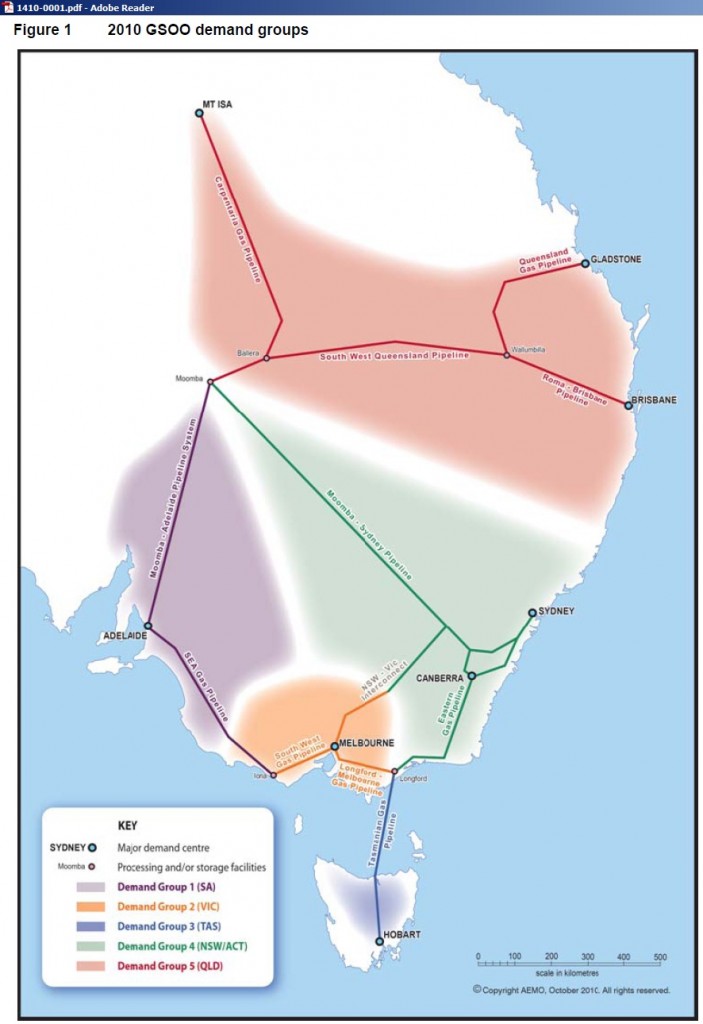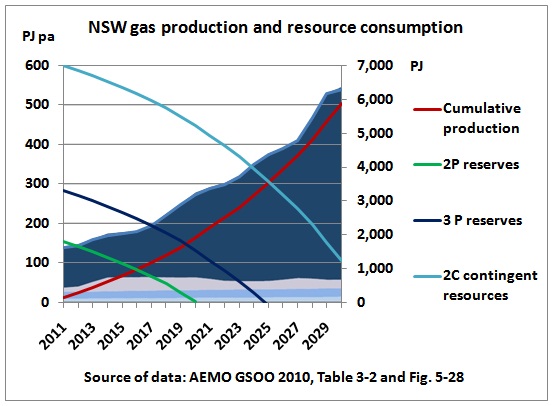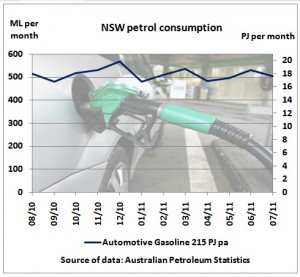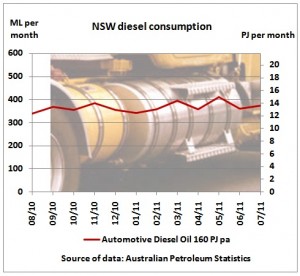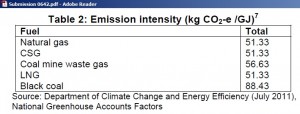Gas series part 2: NSW
 Scarred landscape: 90 coal seam gas wells South of Chinchilla, Queensland
Scarred landscape: 90 coal seam gas wells South of Chinchilla, Queensland
6,000 wells are needed for the QCLNG export project over 20 years. Are we using the gas wisely?
http://www.abc.net.au/news/image/2839944-3×2-700×467.jpg
Summary:
The drama now unfolding is that – because Queensland exports most of its coal seam gas as LNG to foreign countries and not to other States along the East coast – NSW obviously wants to copy what is being done in Qld.
The NSW government’s submission 642 to the CSG Inquiry does not provide any calculations on how much gas is needed for an oil to gas transition in the transport sector. Neither does it say which coal fired power plants will be replaced over which period and how much gas would be required for this task.
Most of the new coal seam gas is used for additional power plant capacities to provide for GDP growth. A smaller, but unspecified amount of gas is needed to top up intermittent renewable energies.
The NSW government confuses gas reserves and resources. It wrongly increases 3P reserves 6-fold. The bloated data are then used to create the impression of hundreds of years of gas supplies, possibly with the intention to push through LNG projects later. What is worse is that burning the claimed gas “reserves” would substantially INCREASE CO2 emissions, equivalent to running the Wiggins coal terminal for 80 years, a timeframe in which Planet Earth would be cooked alive. To build the NSW economy on the basis of wrong and unsustainable calculations will not be successful.
Recommendations:
The NSW submission dated 30/9/2011 must be corrected. To avoid similar future cases an independent Energy Audit department must be established with suitably qualified personnel to vet all energy related government documents before they are published.
Contents
(1) Plans to use gas as transport fuel: mentioned, but no taken seriously
(2) Selection of scenario: NSW doesn’t consider an oil shock
(3) How the NSW CSG is proposed to be used
(4) Calculations to replace petrol and diesel
Appendix: More flaws in the NSW submission
Reserves and resources confused
250 years gas supplies
CSG Emissions equal to running Wiggins coal terminal for 80 years
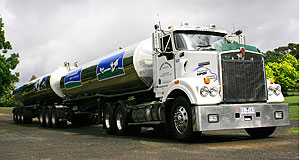 Murray Goulburn Cooperative LNG truck
Murray Goulburn Cooperative LNG truck
(1) Plans to use gas as transport fuel: mentioned, but no calcs
Does the NSW government plan for gas to be used as transport fuel in sufficient quantities to replace oil and does it do the appropriate calculations? Let us analyse the latest thinking in their submission 642 to the Inquiry on coal seam gas.
In the NSW submission we find the following statements:
“The coal seam gas industry has the potential to create thousands of regional jobs, and add billions of dollars to the State economy, reduce our dependence on imported petroleum for transport, and create new industries around the availability of gas as a feedstock” (NSW submission 642, p 4)
“Compressed natural gas (CNG) is being used as transport fuel in buses in Sydney. Trials are being undertaken for use of natural gas in fuel cells to be used in buses and trucks and LNG to be used in long-haul large trucks. CSG can be used in all these applications as it is a direct substitute for natural gas.
There are over 200 trucks converted to LNG in Australia. Owing to its density, greater volumes of LNG fuel can be stored in liquefied form making it more suitable for long-haul heavy vehicles (compared to CNG). There is no movement, however, in the light or passenger vehicle LNG market mainly due to impractical storage requirements.
LNG presents an attractive alternative in the heavy vehicle segment due to its price stability, environmental benefits and proven performance. Historical movements in natural gas pricing (LNG and CNG), have been small relative to annual movements in the price of automotive diesel. As a consequence, it is anticipated that a significant part of the increase associated with the proposed changes to fuel excise will be offset by net increases in the cost of diesel relative to natural gas for transport in Australia – resulting in these fuels remaining relatively attractive within the transport market.
Even a 100% increase in the gas tariffs by 2015 is unlikely to reduce the market attractiveness of these fuels given that the majority of the costs associated with using natural gas are related to compression or liquefaction.” (NSW submission 642, p 18)
So does the NSW government then continue and calculate the gas supply requirements for trucks and buses? No. The above statements are only used as an argument in favour of coal seam gas development.
(2) Selection of scenario: NSW doesn’t consider an oil shock
Let’s have a look at how the coal seam gas is proposed to be used.
“Under a forecast medium growth scenario, over the next 20 years gas demand in NSW is forecast to more than triple to around 550PJ per annum, at an average annual growth rate of 6.9%. New gas-based power generation is projected to start coming on line from 2017, with demand for gas from this sector forecast to increase 12 fold from around 30PJ today to 350PJ per annum in 2030, making up two thirds of total NSW gas demand.” (NSW submission 642, p 10)
The NSW submission uses data from the Gas Statement of Opportunities 2010 by AEMO (Australian Energy Market Operator). http://www.aemo.com.au/planning/1410-0001.pdf
In GSOO 2010 we find on page 97
5.4.1 Key drivers of annual gas demand growth
- economic conditions, in particular, gross domestic product and gross state product growth
- gas-powered generation (GPG) demand, which is expected to grow when a carbon price is
- introduced
- population growth, including growth in the number of residences and residential gas
- connections, and use of gas for residential space heating
- energy efficiency policy measures
- technology changes in gas equipment and appliances
- substitution of electricity for gas and vice versa, for example, reverse-cycle electric air
- conditioners used for heating.
No mention of replacing oil by gas for transport fuels. The NSW government selects among 3 scenarios the Decentralised World scenario from GOSS 2010 (page 135)
- Fast Rate of Change: 4.8% per year, with GPG demand growing at 3.1%
- Decentralised World: 6.9%, with GPG demand growing at 16.9%
- Slow Rate of Change: 4.9%, with GPG demand growing at 12.7%.
The selected scenario is described as:
Decentralised World scenario
In this scenario, domestic gas demand in Eastern and South Eastern Australia increases by more than two and a half times over the 20-year outlook period. Domestic gas demand grows steadily to support economic and industrial growth. GPG demand grows faster in this scenario than in the others due to favourable gas and carbon prices which together, increase GPG competitiveness versus coalfired electricity generation. (AEMO GSOO 2010, page 98)
It is noteworthy that the NSW government did not consider the “Oil Shock and Adaptation” scenario as presented in chapter 6 of the AEMO report “Future Developments in the Stationary Energy Sector” published in October 2009
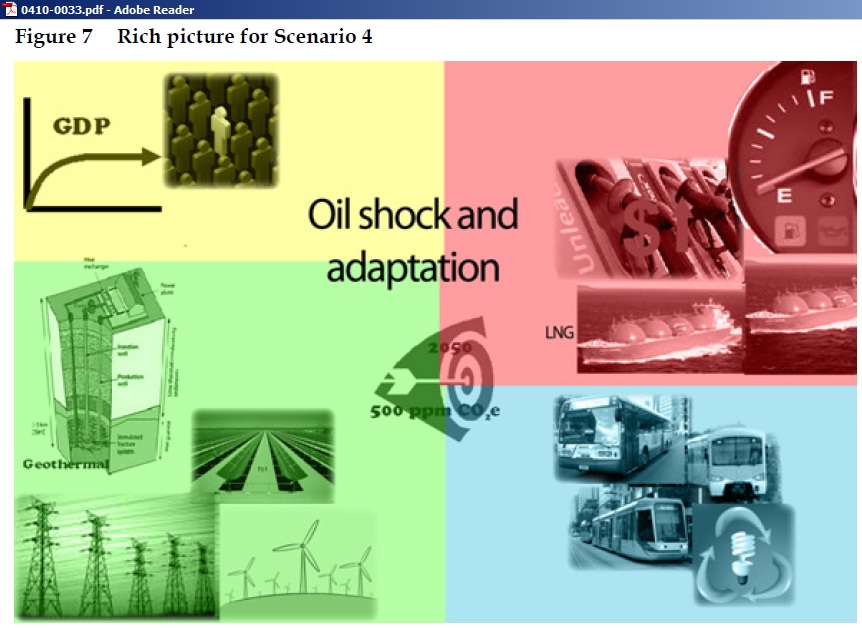 http://www.aemo.com.au/planning/0410-0033.pdf (page 14)
http://www.aemo.com.au/planning/0410-0033.pdf (page 14)
We can clearly see from this image the emphasis on public transport as a solution, but trucks and agricultural machinery are not shown and the conflict with LNG exports is not seen, let alone resolved. A more detailed analysis of this scenario in AEMO documents would be a topic for another article.
 We find this scenario in Fig 5-27 on page 136
We find this scenario in Fig 5-27 on page 136
From that graph we can see 3 distinct phases:
2011-2017: + 5.6% pa
2017-2027: + 7.7% pa
2027-2030: + 9.6 % pa
The selected scenario is not, as mentioned in the NSW submission, a medium scenario but a maximum growth scenario.
(3) How the NSW CSG is proposed to be used
Most of the CSG gas is proposed to be used for power generation and in Sydney. From Fig 5-8 and Fig 5-28
The growth in the non-generating sector is around 2.2 % pa. No gas has been included for use as transport fuel. What’s worse, this gas is mainly used for growth of capacities, not for replacing coal fired power. The NSW submission quotes the “National Transmission Network Development Plan 2010” by AEMO, which contains following graph:
 http://www.aemo.com.au/planning/0410-0066.pdf
http://www.aemo.com.au/planning/0410-0066.pdf
Brown coal is phased out in Victoria but black coal is continued (later CCS – carbon capture and storage – is assumed). Clearly, the NSW government has not understood what NASA climatologist James Hansen said in a lecture at Sydney Uni, in March 2010:
“Australia doesn’t agree now that they got to stop their coal, but they are going to agree. I can guarantee you that within a decade or so because the climate change will become so strongly apparent that’s going to become imperative”
http://www.usyd.edu.au/sydney_ideas/lectures/2010/professor_james_hansen.shtml
While some of the gas powered capacity is needed to even out fluctuations in renewable energies, this has not been quantified in the NSW submission.
How fast are current gas reserves depleted? Based on the reserve and resource data in AEMO’s table 3-2 we can compare
cumulative production with declining 2P and 3P reserves (RHS) which would be depleted by 2025. 2C contingent resources would have to be proved up to continue until 2030. See AEMO tables 3 in the appendix for more details.
(4) Calculations to replace petrol and diesel
So how much gas would we need to replace all diesel and petrol by compressed natural gas (CNG) or liquefied natural gas (LNG)? Here are the statistics:
Source of data: http://www.ret.gov.au/resources/fuels/aps/pages/default.aspx
That’s 160 PJ pa for diesel and 215 PJ pa for petrol, in total the equivalent of 1.7 LNG export trains @ 4 mt pa. The problem is of course that Queensland is building these export facilities right now in Gladstone, instead of using and distributing this gas along the East coast as transport fuel. In other words, NSW now damages its landscape because Queensland is exporting its CSG to foreign countries and not to other States along the East coast.
It is to be feared that NSW wants to repeat/duplicate what Queensland is doing. Here is a plan for 1 mt pa LNG (55 PJ pa)
Eastern Star Gas $2.5 bn LNG plant plan
Appendix: Flaws in the NSW government submission 642 on coal seam gas
(1) Mixing up of reserves and resources, 3P gas reserves wrongly increased 6-fold
In table 1 on page 11, the NSW government submission takes reserve and resource data from page 64 of AEMO’s GSOO 2010 (see next page)
http://www.aemo.com.au/planning/1410-0001.pdf
It then wrongly adds up 3P reserves, 2C resources and prospective resources from tables 3-1, 3-2 and 3-3, adds a massive amount of undocumented CSG for the Gunnedah basin and puts everything into 3P reserves.
This is a blunder of the 1st order. Whether this is incompetence, ignorance, complacency, deliberate “embellishment” or a combination thereof can only be guessed.
 Yes, 3P reserves include P1 and P2 reserves.
Yes, 3P reserves include P1 and P2 reserves.
NO, you cannot add 3P reserves, 2C contingent resources and prospective resources and then call that total “reserves”
The table above is from AEMO. The NSW government should have noticed this error, instead they fell into this trap and added it all up, but made it worse by putting the sum into 3P.
Example: the sum in the row “Bowen-Surat” is inserted in above table 1 as 3P 47,213+62,505+43,817=153,535
(2) 250 years gas supplies
As a consequence of (1), the submission claims in the summary which is read by all those who open the file:
“NSW gas consumption is projected to grow significantly from its current level of around 160 Petajoules (PJ) per annum to 550PJ pa in the next 20 years. Current possible NSW CSG reserves represent over 250 years of gas supply at that level” (page 2)
“Under a forecast medium growth scenario, over the next 20 years gas demand in NSW is forecast to more than triple to around 550PJ per annum, at an average annual growth rate of 6.9%.” (page 10)
So 550 PJ x 250 years = 137,500 PJ
In their table 1 the NSW government has 149,740 PJ for Gunnedah, while the AEMO GSOO 2010 table 3-2 has only 50,000 PJ, a figure which in itself obviously suggests it is a guestimate.
The claim of 250 years of “reserves” is absurd.
(3) And then there are only 6,000 PJ
“Over the next 20 years, CSG reserves in NSW are expected to increase from 2,000PJ to 6,000PJ” (page 12)
Oops. Then why did the NSW submission bother to calculate a whopping 327,666 PJ? The 6,000 PJ would just be enough for the plans from AEMO Fig 5-28
(4) Burning claimed “reserves” would not reduce emissions
“This can be achieved while reducing and diversifying away from our dependence on coal, resulting in a significant reduction in carbon emissions” (page 4)
Let us calculate the CO2 for that CSG gas, using table 2 of the NSW government submission
Total CSG emissions East coast using claimed “reserves”
327,666 PJ x 51.33 kg CO2e / GJ = 327,666 x 10^15 x 51.33 kg CO2e / 10^9
= 327.666 x 51.33 x 10^9 kg CO2e = 16,711 mt CO2e
Australia’s emissions are around 400 mt CO2 pa in the energy sector so that would be 16,711 / 400 = 42 years worth of emissions.
http://www.aph.gov.au/library/pubs/climatechange/whyclimate/human/howMuch/howMuch.htm
Or we could say roughly it is equivalent to 16,711 mt CO2e / 3 tons of CO2e per ton of coal = 5,500 mt of coal = running the Wiggins coal terminal for 80 years @ 70 mt pa
Total CSG emissions in NSW using claimed “reserves”
149,740 PJ x 51.33 kg CO2e / GJ = 7,686 mt CO2e equivalent to 2,562 mt of coal or 15 years of NSW coal production.
That is NOT “clean” as claimed
Without
- specifying which of NSW’s coal fired power plants are going to be closed down
- putting legislation in place which prohibits the coal left in the ground from being exported
the amount of CO2 ending up in the atmosphere from burning the 326,666 PJ of gas “reserves” will be INCREASED, not decreased. So claiming that all this gas would reduce emissions is also factually wrong.
NASA climatologist James Hansen has calculated that if the whole world burnt just 50% of estimated resources of unconventional gas, CO2 concentrations in the atmosphere would go up by 50 ppm. We cannot afford this.
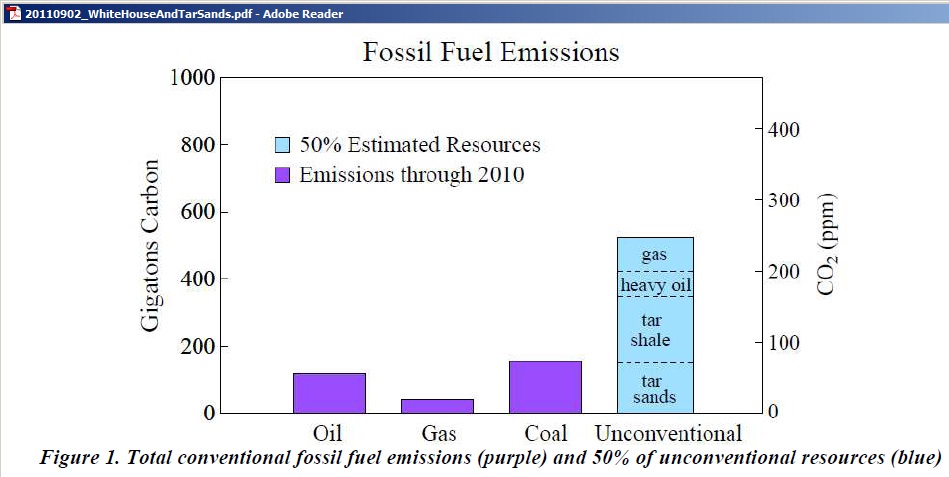 http://www.columbia.edu/%7Ejeh1/mailings/2011/20110902_WhiteHouseAndTarSands.pdf
http://www.columbia.edu/%7Ejeh1/mailings/2011/20110902_WhiteHouseAndTarSands.pdf

